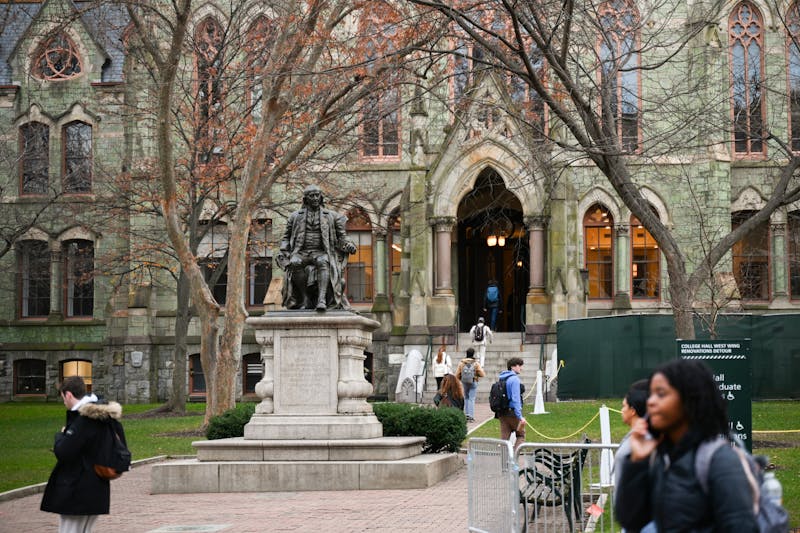
Often, my friends and I eagerly rail against the idea of the corporate, so-called “yuppie,” lifestyle. The thought of following a monotonous nine-to-five routine — confined to a cubicle and endlessly toiling away on spreadsheets, all while benefiting wealthy executives — is a concept we don’t find particularly exciting.
However, we often fail to notice the similarly multilateral, profit-driven nature of our University. Penn has effectively trapped us into serving as pawns in the business of higher education. Now, it’s imperative for us to collectively ascertain the true purpose of this University. This effort starts with expediting Penn’s admissions reforms, particularly those related to legacy admissions.
Penn finds itself grappling with the challenge of unequivocally asserting its identity as a business rather than a more innocent social enterprise. My politics don’t entirely align with those who call out private universities in their broader campaigns against capitalism. However, events surrounding the recent resignations of former President Liz Magill and Board of Trustees Chair Scott Bok have only further unveiled the pitfalls of Penn’s overarching revenue framework.
Critics of the administrative upheaval argue that Magill and Bok were not even driven by student interests but rather by threats of donor withdrawal. We only continue to remain baffled on what, exactly, prompted Magill’s infamous testimony during December’s congressional hearing on campus antisemitism. However, the argument that Magill and Bok were actively intending to discriminate against students is thin.
Legacy admissions are the latest aspect of Penn’s administrative system to face national scrutiny for allegations of racial discrimination. But if Penn’s change in leadership has taught us anything, it’s that the University is not as reactive to our culture wars as it is to financial issues. Legacy admissions, in particular, serve as a means to incentivize donors to retain ties to the University.
I won’t go into the specific and often confusing details of Penn’s revenue model. But to give a sense of why the supposedly necessary legacy admissions are in question at all, it’s important to note that over 58% of Penn’s operating revenue, around $8.7 billion annually, is derived from its net patient service revenue. This value represents the total income generated by Penn’s healthcare facilities in providing patient services. However, expenditures for the University’s Health System (UPHS) typically exceed those for academic purposes. Barring revenue related to UPHS, other sources of operating revenue — the most notable being net tuition and fees — amount to less than $7 billion annually. And yet, total operating expenses approach $14 billion.
Essentially, without sources of non-operating income, such as grants, royalties, and returns on investments, Penn would hardly break even. Of course, it’s not uncommon for private universities like Penn to use diverse revenue streams. This model allows Penn to maintain an endowment payout rate of 5%, which is the amount of Penn’s financial reserves allocated for spending each year.
And in this vein, Penn is much better off than its counterparts.
Princeton University, for instance, received $1.85 million in private gifts during the last fiscal period. Its operating revenue amounted to $2.5 billion while operating expenses totaled $2.3 billion. Unlike Penn, Princeton does not operate a healthcare system or a similar subsidiary. Approximately 66% of Princeton's financial support is derived from investments due to relatively limited earnings from tuition and contracts.
On the other hand, Brown University reported an operating revenue of $1.53 billion, slightly lower than its operating expenses of $1.57 billion. Notably, Brown raised over $400 million in the same fiscal year, with a significant 90% of this funding sourced from alumni and parents.
Princeton, in contrast, boasts a higher payout rate of 8%, allowing for more immediate financial support. However, a higher payout rate also carries the risk of depleting the endowment over time.
It is evident that Penn does not rely disproportionately on donor, let alone alumni, contributions compared to peer institutions. As it happens, Penn is better situated to handle the risk of donor withdrawal due to its more diverse sources of revenue. This condition allows for discussions regarding the removal of legacy admissions, considering that some donors may feel less inclined to give if their children don’t receive preferential treatment during admissions.
But these metrics beg the question: Why do legacy admits bear the inadvertent responsibility of ensuring Penn’s donor retention? Ironically, we depict our campus as a beacon of knowledge. We aren't just regurgitating ideas from textbooks; we are actively shaping them. Yet how can this be, when many of us who pay to receive an education at Penn are also entangled in its bureaucratic financing structure? Because as the University’s — dare I say, excessive — dependence on donor contributions shifts the burden of funding onto students, it undermines the notion of education as largely a public good.
Again, Penn isn’t alone in this precarious situation, but we must acknowledge that the donation-oriented system that upholds legacy admissions played a more significant role in Magill and Bok’s resignations than actual student grievances. Therefore, if the University wishes to align with its stated values, it must eliminate legacy admissions.
MRITIKA SENTHIL is a first year studying Management and Russian & East European Studies from Columbia, S.C. Her email is mritikas@upenn.edu.
The Daily Pennsylvanian is an independent, student-run newspaper. Please consider making a donation to support the coverage that shapes the University. Your generosity ensures a future of strong journalism at Penn.
Donate











